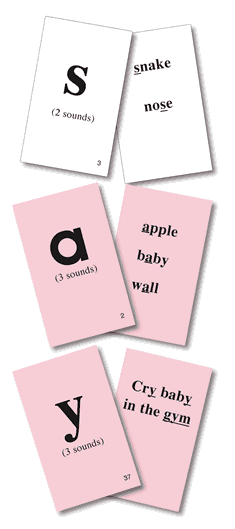|
 |
Before Every
Phonics Lesson: The Letter/Sound Cards
Knowing the letter sounds automatically
is critical for skilled reading.
Use them to start each lesson
— It’s like brushing your teeth to start the day!
(Instructions in the Teacher’s
Guide)
 |
 |
|
Purpose:
To learn and review the sounds of
all the most common letters and letter combinations.
The Teacher’s Guide gives tips to help students learn
to read and spell them.
Features:
- For the youngest students, the
cards can be used to learn the letter names, the
alphabet and to play games.
- Students can learn a new letter
sound and then use the corresponding Word Cards for
practice.
- The cards are numbered to give
a practical learning sequence, although the reading
teacher can vary this to fit the needs of her students.
- For beginning blending,
the reading teacher can learn to flip the cards
to make phonetic words. (Instructions in Teacher’s
Guide).
- Reading teachers can use the list
of all the 65 Letter Cards found in The Guide to
make individual cards for small groups and individual
students. (Instructions in Teacher’s Guide).
- Many letters can be pronounced
in more than one way. The number of pronunciations,
if more than one, is noted on the front of the card
and the full list is in the Teacher’s Guide. An example
of each possible pronunciation is shown with a key
word or a memory trick phrase or sentence on the
back of the card. The possible pronunciations are
written in the order of frequency they are found
in English.
- Vowels are on pink cards; consonants
are on white.
- The students learn the most common
pronunciation of the letters first. As they are able,
the other pronunciations are learned and reinforced
with The Word Cards in Phonics In A Box
|
 |
 |
 |
A Sample Orton-Gillingham
strategy from Teacher’s Guide:
“Some students may need
intense multisensory training to succeed. They say the
name of the letter the teacher shows (m), then a key
word, (man) and then they write the letter on paper,
in sand, or on the desk with their finger as they say
the sound /m/.” |
| |
|
|
|